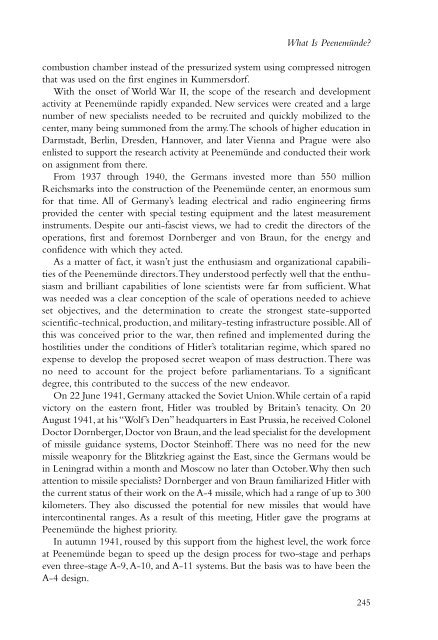to open next chapter. - NASA's History Office
to open next chapter. - NASA's History Office
to open next chapter. - NASA's History Office
You also want an ePaper? Increase the reach of your titles
YUMPU automatically turns print PDFs into web optimized ePapers that Google loves.
What Is Peenemünde?<br />
combustion chamber instead of the pressurized system using compressed nitrogen<br />
that was used on the first engines in Kummersdorf.<br />
With the onset of World War II, the scope of the research and development<br />
activity at Peenemünde rapidly expanded. New services were created and a large<br />
number of new specialists needed <strong>to</strong> be recruited and quickly mobilized <strong>to</strong> the<br />
center, many being summoned from the army.The schools of higher education in<br />
Darmstadt, Berlin, Dresden, Hannover, and later Vienna and Prague were also<br />
enlisted <strong>to</strong> support the research activity at Peenemünde and conducted their work<br />
on assignment from there.<br />
From 1937 through 1940, the Germans invested more than 550 million<br />
Reichsmarks in<strong>to</strong> the construction of the Peenemünde center, an enormous sum<br />
for that time. All of Germany’s leading electrical and radio engineering firms<br />
provided the center with special testing equipment and the latest measurement<br />
instruments. Despite our anti-fascist views, we had <strong>to</strong> credit the direc<strong>to</strong>rs of the<br />
operations, first and foremost Dornberger and von Braun, for the energy and<br />
confidence with which they acted.<br />
As a matter of fact, it wasn’t just the enthusiasm and organizational capabilities<br />
of the Peenemünde direc<strong>to</strong>rs.They unders<strong>to</strong>od perfectly well that the enthusiasm<br />
and brilliant capabilities of lone scientists were far from sufficient. What<br />
was needed was a clear conception of the scale of operations needed <strong>to</strong> achieve<br />
set objectives, and the determination <strong>to</strong> create the strongest state-supported<br />
scientific-technical, production, and military-testing infrastructure possible.All of<br />
this was conceived prior <strong>to</strong> the war, then refined and implemented during the<br />
hostilities under the conditions of Hitler’s <strong>to</strong>talitarian regime, which spared no<br />
expense <strong>to</strong> develop the proposed secret weapon of mass destruction.There was<br />
no need <strong>to</strong> account for the project before parliamentarians. To a significant<br />
degree, this contributed <strong>to</strong> the success of the new endeavor.<br />
On 22 June 1941, Germany attacked the Soviet Union.While certain of a rapid<br />
vic<strong>to</strong>ry on the eastern front, Hitler was troubled by Britain’s tenacity. On 20<br />
August 1941, at his “Wolf’s Den” headquarters in East Prussia, he received Colonel<br />
Doc<strong>to</strong>r Dornberger, Doc<strong>to</strong>r von Braun, and the lead specialist for the development<br />
of missile guidance systems, Doc<strong>to</strong>r Steinhoff. There was no need for the new<br />
missile weaponry for the Blitzkrieg against the East, since the Germans would be<br />
in Leningrad within a month and Moscow no later than Oc<strong>to</strong>ber.Why then such<br />
attention <strong>to</strong> missile specialists? Dornberger and von Braun familiarized Hitler with<br />
the current status of their work on the A-4 missile, which had a range of up <strong>to</strong> 300<br />
kilometers. They also discussed the potential for new missiles that would have<br />
intercontinental ranges. As a result of this meeting, Hitler gave the programs at<br />
Peenemünde the highest priority.<br />
In autumn 1941, roused by this support from the highest level, the work force<br />
at Peenemünde began <strong>to</strong> speed up the design process for two-stage and perhaps<br />
even three-stage A-9, A-10, and A-11 systems. But the basis was <strong>to</strong> have been the<br />
A-4 design.<br />
245
















